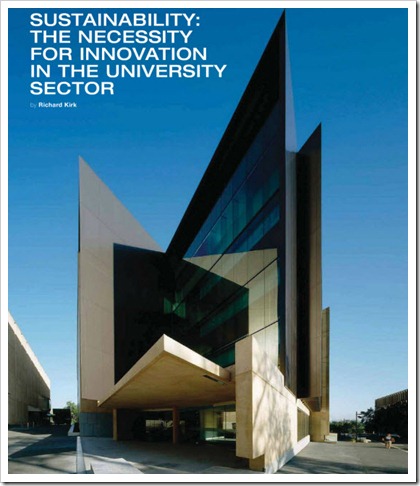
In the last few years, sustainability in the built environment has shitted from a position of desirability to one of urgent necessity in the challenge to make our cities more resilient. In addition, recent natural disasters have forced a rethink about how our cities are planned and managed. Earthquakes in Japan and New Zealand, typhoons in the United States, and floods in Australia and China have challenged accepted ideas of sustainability and brought into sharp relief the urgent need to address the resilience of our built environment.
The great extent of suffering in the example of the earthquake and tsunami in Japan has left not just devastation but lasting shortages of power supply. The required rationing of power challenges the very fundamentals of the city form and the commercial standard of hermetically sealing buildings that rely on artificial climate control. This approach makes these buildings immediately unusable upon even a short power outage and ultimately unsustainable.
From these lessons, the sustainability discussion needs to broaden to include provisioning for cities that don't rely on the availability of power and instead shift toward passive design solutions. Traditional building stocks, which were designed before the arrival of mechanical ventilation and inexpensive lighting, contain lessons that deserve further Investigation and re-examination.
To date, planning authority controls and commercial leasing trends have dictated the status of sustainability within the design process. This has been manifested in codified legislation or the adoption of voluntary Green rating schemes. Although sustainability legislation and rating schemes have helped to broadly introduce a set of shared principles, they have also fostered a level of complacency. By reducing the design process to a series of defined guidelines, innovation is limited and the sustainability agenda is shifted away from broad investigation and interrogation of sustainable design.
In the case of working in both the university sector and in the delivery of private residences, there exists the opportunity for architects to expand approaches to sustainability in the built environment beyond simply addressing predefined minimum requirements. With the client being both ultimate building owner and end user, the sustainability agenda for a project expands to address broader issues, including both capital and lifecycle costs; building life; maintenance; and indoor environmental quality.
Within the university context an even broader architectural remit is required beyond sustainability and resilience, as educational institutions have a responsibility to experiment, innovate and inform through their architecture. As places of learning it is incumbent upon these institutions to not only demonstrate leadership technologically but to also broaden the concept of sustainability and critical thinking within this discipline.
In their position as leading centers of knowledge, universities have not only an obligation to experiment with new ideas and to challenge the current standards and benchmarks in the built environment, but also to treat the process of designing, occupying, and operating buildings and environments as a form of research in itself. Amplifying this requirement to innovate is the rapid increase in international competition between universities for students, academic staff and research grants. In this environment of competition, landmark sustainable buildings that provide quality environments and a sense of place are increasingly becoming critical learning and marketing tools for universities.
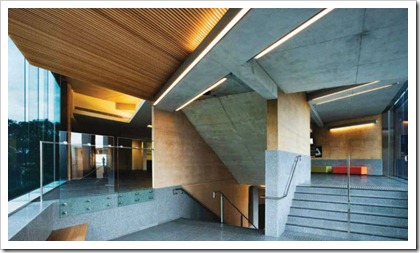
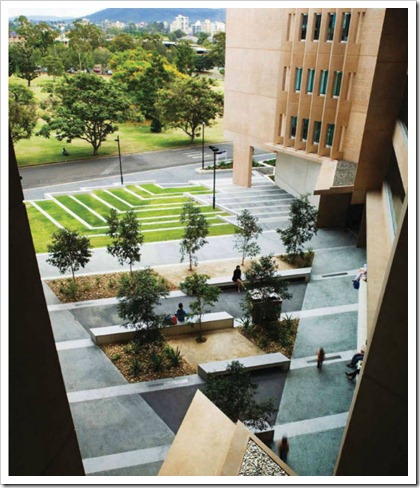
Within the university context an even broader architectural remit is required beyond sustainability and resilience, as educational institutions have a responsibility to experiment, innovate and inform through their architecture.
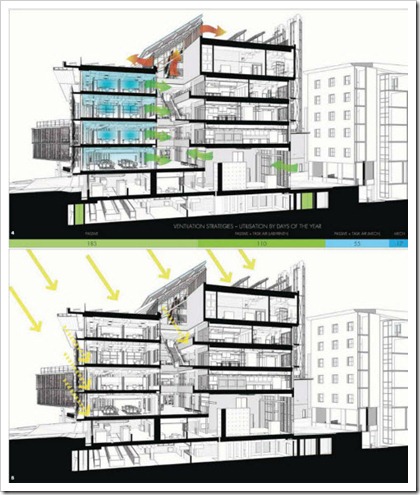
Unlike typical university buildings, architecturally designed houses have traditionally favored passive sustainability solutions rather than a reliance on complex and costly active technologies. Architects with extensive experience in applying these approaches to residential projects are now in a position to implement these sensibilities on the larger and more complex works of university and institutional projects. In some examples to date, this has resulted in the successful application of new organizational strategies, materials, and environmental responses for complex projects.
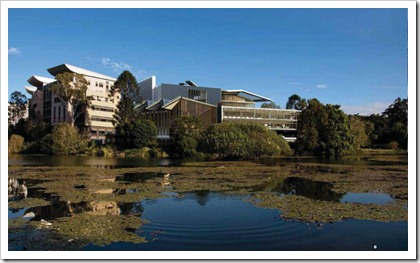
Completed in 2008, the Sir Llew Edwards Building1 at the University of Queensland's St Lucia Campus in Brisbane. Australia incorporates a number of sustainability features. However, given its commissioning in the early part of the 21s" century, sustainability was still a low priority for the University. Unfortunately this still is the case for many clients in other sectors. Given this climate, the leadership role of the architect is paramount in guiding clients to innovative approaches, whilst recognizing their inherent conservatism and providing methodologies to innovate while managing perceived risks. Gradual rather than radical testing across projects is an appropriate response to this desire for certainty in the conservative delivery environment. Overarching philosophies of design can provide consistency and certainty across project types, while still maintaining a programmed of consistent learning and refinement from project to project.
Given the period and the client's then appetite for innovation, the Sir Llew Edwards Building still introduced a number of new sustainability features for the University. Responding to Brisbane's subtropical climate, landscape plays a rich part in the built environment. This building responds by opening interior spaces to views of the University landscape and capturing courtyard spaces within the building form, which protects them during inclement weather. Facade treatments and thin floor plates respond to internal use requirements by providing natural daylight and greater transparency of building occupation and operation. The building also incorporates an extensive array of photovoltaic panels, which contribute to the University's Mega Array of 1.22MW, which will account for 6 percent of peak load.
Currently under construction and scheduled for completion in 2013, the Advanced Engineering Building2 at the University of Queensland, is an exemplar of the rapidity with which sustainability is being embraced by the University. Commissioned only a few years after the Sir Llew Edwards
Building, the Advanced Engineering Building incorporates a dramatically broader and deeper approach to sustainability. Much of this is achieved through the adoption of existing and sometimes common strategies, which are overlaid to provide exponentially better outcomes. The design favors a primarily passive response to sustainability and embraces new methods of training young engineers with a pedagogy focused on hands-on learning.
At the forefront of the building's philosophy towards sustainability is the conception of the structure as a live building'. Fulfilling the need for universities to educate and inform, real time monitoring of the building's performance in both climatic and structural terms is done to a fine level and displayed throughout the various spaces. In this way the building itself becomes a lifelong learning tool, which is incorporated into the curriculum. Given the building's role as a learning environment for future generations of engineers, the need for the sustainability response to be comprehensible and incorporated into the pedagogy and curricula was essential.
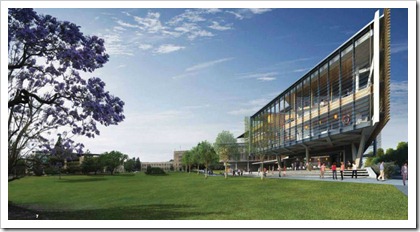
The design process also required the traditional concept of the university workplace to be challenged. The quantity of closed cellular spaces was reduced, which when combined with the inclusion of a central atrium allowed for better cross ventilation and daylight access for internal spaces while developing a new type of workplace for academics. These outcomes are typically difficult to deliver in the design of a 22,000-square meter building. To achieve this, significant change management was required from the architect, in addition to design skills, in order to overcome ingrained and outdated concerns about privacy, security, hierarchy and status.
Additional innovations in the Advanced Engineering Building include the use of a labyrinth system with phase change materials to pre-temper and dehumidify air, additional photovoltaic panels for the University's Mega Array and permeable facades with high levels of fixed and active solar protection to provide passive ventilation and shading. The building also expresses its extensive use of timber in structural systems for facades and roofs. This is a result of the architect's deep interest in developing construction methods and material knowledge to produce buildings that respond directly to each client, brief and circumstance.
In this way, architects are also able to foster and facilitate the most sustainable local industries through the production of a body of work that provokes a sustainable design model. In the case of the Advanced Engineering Building, the application of small project skills on large projects has resulted in grander scale use of local timber in a number of projects. This not only fosters and explores new potentials in traditional industries but also provokes a response in terms of greater scale and sophistication. It also triggers greater utilization of existing sustainable industries that have previously been denied access to larger sectors of construction due to established conservatism. It is critical that architects act in this way to develop sustainable approaches that can be adopted widely, broadly and immediately.
Currently in the design phase, the new Business School' for the University of Queensland again evolves, extends and iterates on responses developed to achieve sustainable outcomes in the Advanced Engineering Building. In this case the site, brief and client-specific strategies are now being applied to a different building typology, site context and most importantly the climate of ever-increasing understanding of and sensitivity to issues of sustainability.
This trend is only likely to continue into the future and the role of the architect will become ever more important in advocating new standards of sustainability and resilience of our built environments for the community. As the construction and design market increasingly focuses on new Green building standards, it is imperative that architects continue to create space for innovation within the broad agenda of sustainability, rather than allow pre-defined Green building solutions to dominate. Through combined engagement with numerous collaborators, client types, institutions, Government bodies and professional organizations, the architect is able to most effectively practice and provide agency for sustainability within the built environment.
by Richard Kirk Architect
0 comments:
Post a Comment